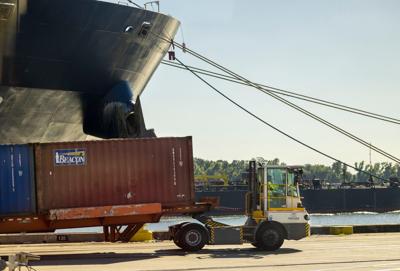Louisiana’s longshoremen headed back to the docks at noon on Friday, ending a three-day strike that shuttered U.S. container ports from Maine to Texas, including operations at New Orleans and Baton Rouge.
Port of New Orleans officials said container operations at the two major stevedore companies, Ports America and the New Orleans Terminal consortium, appeared to be getting back to normal on Friday afternoon. Henry Glover, president of International Longshoremen's Association Local 3000, which represents longshoremen in Louisiana, said his members are happy they didn't have to endure a protracted work stoppage.
"We didn't want this to drag on so we're relieved," he said.

Fourth generation longshoreman Henry Glover, ILA Local 3000 president, poses as International Longshoremen Association members strike for the first time since 1977 at the Felicity Street entrance to Port NOLA in New Orleans, Tuesday, Oct. 1, 2024. (Photo by Sophia Germer, The Times-Picayune)
The United States Maritime Alliance, which represents the shipping companies in negotiations, and the longshoremen's union said Thursday that they had reached a tentative deal on wages and would extend their talks over job security and limiting dockside automation until January 15. The two parties met halfway on wages, agreeing to a 62% pay increase that will be phased in over six years.
The strike, which began on Tuesday, threatened to cripple the movement of goods a month before the U.S. presidential election and the beginnings of the holiday shopping season.

International Longshoremen Association members strike at the Felicity Street entrance to Port NOLA in New Orleans, Tuesday, Oct. 1, 2024. (Photo by Sophia Germer, The Times-Picayune)
The ILA represents around 1,300 dockworkers in Louisiana. New Orleans is a major importer of coffee and some other bulk cargoes. But the focus of the work stoppage was related to a contract with the major container shipping companies, which meant that that 600 to 700 workers that help manage the 1,500 standard 20-foot containers that move through New Orleans on an average day were the ones that hit the picket lines.
Another picket?
The local members of the ILA made their way back to their cranes and forklifts at the Napoleon Avenue container terminal a little before midday on Friday. But as they drove past the Felicity Avenue entrance to the docks where they were picketing less than a day earlier, another group was mounting their own protest.
About 150 independent truck drivers, who are not union members, staged work stoppages at ports in New Orleans, Charleston and Virginia to draw attention to demands for better rates and improved conditions.
The truckers at the Felicity Street gates said that they had waited to mount their own protest because they didn't want to deflect from the longshoremen's efforts. But they said they also have been falling behind because of inflation.
"The rates are extremely low across the board right now and it's been going on at least two years," said Lysander Shaw, who was the main organizer of the New Orleans truckers' protest through a Facebook group called NOLA Trucks.

As dockworkers prepared to go back to work at Port of New Orleans on Friday, a group of independent truckers gathered at the Felicity Street port entrance in the hope of keeping disruption going to bring attention to their demands for better pay rates and conditions from shippers.
He said that just as important as the rates are conditions they face when loading at the ports, where they must sometimes wait on line for several hours before they can load or unload.
"We waste two, three hours because of delays in there and we're not getting any compensation for that," said Ron Hall, one of the truck owner-operators who joined Friday's protest. He said as owners of the rigs, they must bear all the costs of fuel, maintenance and repair, and they have very little leverage with the shipping companies to press for fairer compensation.
About 1,000 trucks a day come through the Felicity Avenue entrance and make their way to Napoleon Avenue facilities to load and unload containers.
The truckers said they are hoping to disrupt operations enough to draw attention to their grievances. However, the major dispute with the longshoremen that threatened to cause upheaval to more than half of the U.S. supply chain and potentially reignite price inflation has been averted at least until January.
"There has been no disruption in port operations stemming from the truckers’ protest," said Stacey Schexnayder, a spokesperson for Port NOLA.
Glover said that while his members support the protesting truckers, they are independent contractors and not members of a union, so the ILA members returned to work despite the picket lines. Glover said they are not likely to cause any major disruptions.
Though some trucks appeared to be moving through the port gates on Friday, Shaw said he and the other independent truckers plan to stay on the picket line and withhold their labor until the shipping companies agree to talk.
"We can't keep on like this. We all have to make a decent livelihood so we can look after our families," he said.






